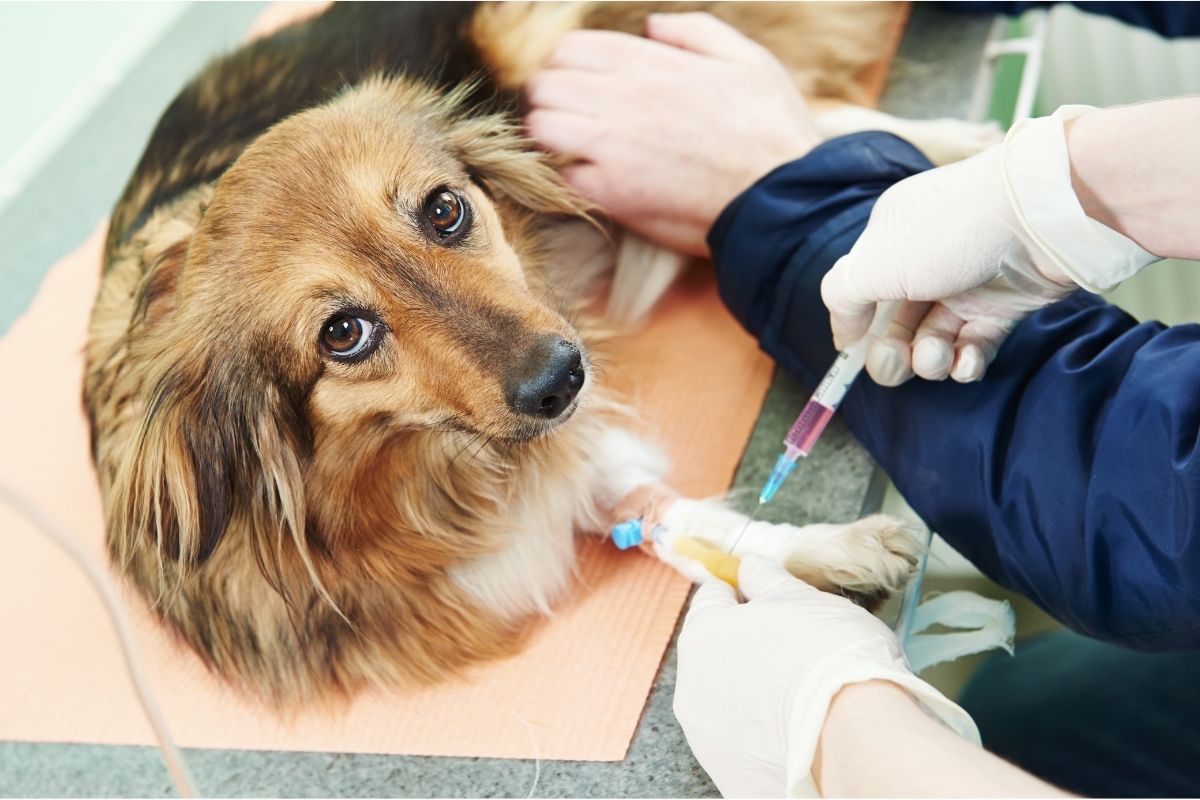Home>Health & Wellness>Common Health Issues>How High Is Your Dog’s Blood Sugar When Your Dog Gets Diabetes


Common Health Issues
How High Is Your Dog’s Blood Sugar When Your Dog Gets Diabetes
Published: January 30, 2024
Learn about common health issues in dogs, including diabetes and high blood sugar levels. Understand the impact on your dog's health and how to manage these conditions effectively.
(Many of the links in this article redirect to a specific reviewed product. Your purchase of these products through affiliate links helps to generate commission for Pawsomeoldies.com, at no extra cost. Learn more)
Table of Contents
Introduction
Canine diabetes, a condition characterized by high blood sugar levels in dogs, is a growing concern among pet owners and veterinarians. Just like humans, dogs can develop diabetes, and it's essential for dog owners to be aware of the signs, symptoms, and management of this condition.
Understanding the impact of diabetes on dogs is crucial for providing them with the best possible care and ensuring their well-being. From recognizing the early signs of high blood sugar to implementing effective management strategies, staying informed about canine diabetes is key to supporting your furry companion's health.
In this comprehensive guide, we will delve into the intricacies of canine diabetes, shedding light on the symptoms of high blood sugar in dogs, the diagnostic process, and practical approaches to managing your dog's blood sugar levels. By gaining a deeper understanding of this condition, you can empower yourself to take proactive measures to support your dog's health and quality of life.
Join us on this enlightening journey as we explore the world of canine diabetes, unraveling its complexities and equipping you with valuable insights to ensure the well-being of your beloved canine companion.
Understanding Canine Diabetes
Canine diabetes, similar to diabetes in humans, is a complex metabolic disorder that affects dogs, impacting their ability to regulate blood sugar levels effectively. This condition arises when the pancreas fails to produce sufficient insulin or when the body becomes resistant to the insulin produced. Insulin plays a crucial role in facilitating the uptake of glucose from the bloodstream into the cells, where it is utilized as a source of energy. When this process is disrupted, it leads to elevated blood sugar levels, known as hyperglycemia, which can have detrimental effects on a dog's health.
There are two primary forms of diabetes that can affect dogs: Type 1 diabetes, which occurs when the pancreas is unable to produce adequate insulin, and Type 2 diabetes, characterized by insulin resistance, where the body's cells do not respond effectively to insulin. While Type 1 diabetes is more common in dogs, Type 2 diabetes can also occur, particularly in older and overweight dogs.
Several factors can contribute to the development of diabetes in dogs, including genetic predisposition, obesity, pancreatitis, and certain medications. Breeds such as Golden Retrievers, German Shepherds, and Poodles are believed to have a higher susceptibility to diabetes, highlighting the influence of genetics on the condition.
Understanding the impact of diabetes on dogs is essential for pet owners, as it can manifest in various ways, affecting the overall well-being of their furry companions. Dogs with diabetes may experience increased thirst and urination, weight loss despite a hearty appetite, lethargy, and recurrent urinary tract infections. Additionally, cataracts, a clouding of the lens in the eye, can develop in diabetic dogs, leading to impaired vision if left untreated.
Managing canine diabetes requires a multifaceted approach, encompassing dietary modifications, regular exercise, and, in some cases, insulin therapy. By gaining a deeper understanding of this condition, pet owners can play a proactive role in supporting their dog's health and quality of life. Recognizing the early signs of diabetes and seeking prompt veterinary care is crucial for effectively managing the condition and mitigating its impact on a dog's well-being.
As we delve deeper into the realm of canine diabetes, it becomes evident that awareness and education are pivotal in addressing this prevalent health concern among dogs. By equipping ourselves with knowledge and understanding, we can navigate the complexities of canine diabetes and provide our beloved canine companions with the care and support they need to thrive.
Symptoms of High Blood Sugar in Dogs
Recognizing the symptoms of high blood sugar in dogs is crucial for early detection and intervention in cases of canine diabetes. Dogs with elevated blood sugar levels may exhibit a range of signs and symptoms that warrant attention from pet owners and veterinary professionals. By being attuned to these indicators, dog owners can take proactive measures to address potential health concerns and seek timely veterinary care.
-
Increased Thirst and Urination: One of the hallmark symptoms of high blood sugar in dogs is polydipsia (excessive thirst) and polyuria (frequent urination). Dogs may display an insatiable thirst, often drinking large volumes of water, and subsequently urinating more frequently than usual. This noticeable change in drinking and urination patterns can be indicative of elevated blood sugar levels and should prompt further evaluation by a veterinarian.
-
Weight Loss: Despite maintaining a healthy appetite, dogs with high blood sugar levels may experience unexplained weight loss. This paradoxical combination of increased hunger and weight loss can be attributed to the body's inability to utilize glucose effectively, leading to the breakdown of fat and muscle tissue for energy.
-
Lethargy and Weakness: Dogs suffering from high blood sugar levels may exhibit lethargy, weakness, and a general lack of energy. This can manifest as reduced interest in physical activities, reluctance to engage in exercise, and overall diminished vitality.
-
Change in Appetite: While some dogs may experience increased hunger and food consumption, others may exhibit a decreased appetite or a reluctance to eat. Changes in eating habits, particularly when accompanied by other symptoms, can signal underlying health issues, including high blood sugar levels.
-
Recurrent Infections: Dogs with uncontrolled diabetes are more susceptible to urinary tract infections and skin infections. Recurrent or persistent infections, particularly in the urinary tract, may indicate compromised immune function associated with high blood sugar levels.
-
Vision Changes: High blood sugar levels can contribute to the development of cataracts in dogs, leading to impaired vision. Cloudiness or opacity in the eyes, along with signs of visual impairment, should prompt a thorough evaluation by a veterinarian to assess the dog's ocular health.
By being vigilant and observant of these symptoms, dog owners can play a proactive role in identifying potential health concerns related to high blood sugar levels in their pets. Seeking prompt veterinary care and diagnostic testing is essential for confirming a diagnosis of diabetes and implementing appropriate management strategies to support the dog's well-being.
As we delve into the intricate manifestations of high blood sugar in dogs, it becomes evident that early recognition and intervention are pivotal in addressing potential health issues associated with canine diabetes. By staying attuned to these symptoms and seeking professional guidance, pet owners can prioritize their dog's health and take proactive steps to mitigate the impact of high blood sugar levels on their beloved furry companions.
Diagnosing Diabetes in Dogs
Diagnosing diabetes in dogs involves a comprehensive approach that encompasses clinical evaluation, laboratory tests, and diagnostic procedures aimed at confirming the presence of high blood sugar levels and assessing the overall health status of the canine patient. Veterinary professionals rely on a combination of clinical signs, blood tests, and urine analysis to establish a definitive diagnosis of diabetes in dogs.
When a dog presents with symptoms suggestive of diabetes, such as increased thirst, excessive urination, unexplained weight loss, and changes in appetite, the veterinarian conducts a thorough physical examination to assess the dog's overall health and gather pertinent clinical information. During the examination, the veterinarian may inquire about the dog's medical history, including any previous health concerns, dietary habits, and lifestyle factors. This comprehensive assessment serves as the foundation for the diagnostic process, guiding the veterinarian in formulating an appropriate diagnostic plan tailored to the individual needs of the canine patient.
Laboratory tests play a pivotal role in diagnosing diabetes in dogs, with blood glucose measurements serving as a primary indicator of the dog's blood sugar levels. A fasting blood glucose test, which involves obtaining a blood sample after an overnight fast, helps determine the dog's baseline blood sugar level. Additionally, a series of blood tests, including glycated hemoglobin (HbA1c) and fructosamine levels, may be performed to assess the dog's long-term blood sugar control and provide valuable insights into the presence of diabetes.
Urine analysis is another essential component of the diagnostic process, as it can reveal the presence of glucose in the dog's urine, a hallmark feature of diabetes. By examining a urine sample for the presence of glucose and ketones, veterinary professionals can gain further evidence to support the diagnosis of diabetes in dogs.
In some cases, additional diagnostic imaging, such as abdominal ultrasound, may be recommended to evaluate the dog's pancreatic health and assess for potential complications associated with diabetes, such as pancreatitis. This comprehensive approach to diagnosing diabetes in dogs enables veterinary professionals to gather essential diagnostic data, confirm the presence of high blood sugar levels, and assess the overall health status of the canine patient.
By leveraging a combination of clinical evaluation, laboratory tests, and diagnostic imaging, veterinarians can establish a definitive diagnosis of diabetes in dogs, paving the way for tailored treatment and management strategies. Early diagnosis is pivotal in addressing diabetes in dogs, as it allows for timely intervention and the implementation of effective management approaches to support the dog's health and well-being.
As we delve into the intricate process of diagnosing diabetes in dogs, it becomes evident that a thorough and systematic approach is essential for confirming the presence of high blood sugar levels and initiating appropriate care for canine patients. By prioritizing early detection and diagnosis, veterinary professionals and pet owners can collaborate to address diabetes in dogs proactively, ensuring optimal health outcomes for their beloved furry companions.
Managing Your Dog's Blood Sugar
Managing your dog's blood sugar levels is a crucial aspect of supporting their overall health and well-being, particularly in cases of diabetes. A multifaceted approach to blood sugar management encompasses dietary modifications, regular exercise, and, in some instances, insulin therapy, aimed at optimizing your dog's blood sugar control and enhancing their quality of life.
Dietary Considerations
Diet plays a pivotal role in managing your dog's blood sugar levels. A well-balanced and carefully regulated diet can help stabilize blood sugar and support overall metabolic health. When it comes to diabetic dogs, a veterinarian may recommend a specialized diet that is high in fiber and complex carbohydrates, which can help regulate blood sugar levels and minimize fluctuations. Additionally, feeding your dog consistent meals at scheduled times can contribute to better blood sugar control, as it aligns with insulin administration and promotes a predictable feeding routine.
Regular Exercise
Regular physical activity is beneficial for dogs with diabetes, as it can aid in regulating blood sugar levels and promoting overall fitness. Engaging your dog in consistent, moderate exercise, such as brisk walks and interactive play sessions, can contribute to improved insulin sensitivity and glucose utilization. However, it's essential to coordinate your dog's exercise regimen with their dietary and insulin schedule to prevent drastic fluctuations in blood sugar levels.
Insulin Therapy
In cases where a dog's diabetes requires insulin supplementation, adhering to a prescribed insulin regimen is paramount for maintaining optimal blood sugar control. Administering insulin as directed by your veterinarian, typically through subcutaneous injections, is essential for regulating blood sugar levels and preventing hyperglycemia. Close collaboration with your veterinarian is crucial to determine the appropriate insulin dosage and frequency, as well as monitoring your dog's response to insulin therapy through regular blood glucose testing.
Monitoring and Veterinary Care
Regular monitoring of your dog's blood sugar levels, as well as periodic veterinary check-ups, are integral components of effective blood sugar management. Home blood glucose monitoring, under the guidance of your veterinarian, allows you to track your dog's blood sugar levels and make informed adjustments to their management plan as needed. Additionally, routine veterinary examinations enable your veterinarian to assess your dog's overall health, evaluate their response to treatment, and make any necessary modifications to their blood sugar management regimen.
By implementing a comprehensive approach to managing your dog's blood sugar, encompassing dietary considerations, regular exercise, insulin therapy, and diligent monitoring, you can play an active role in supporting your dog's health and well-being. Collaborating closely with your veterinarian and staying attuned to your dog's individual needs and responses to treatment are essential for optimizing their blood sugar control and fostering a fulfilling and vibrant life for your beloved canine companion.
Read more: When Should I Put Down My Diabetic Dog?
Conclusion
In conclusion, the realm of canine diabetes encompasses a multifaceted landscape, characterized by the intricate interplay of metabolic imbalances, clinical manifestations, and comprehensive management strategies. As we navigate the complexities of this prevalent health concern among dogs, it becomes evident that awareness, education, and proactive intervention are pivotal in addressing the impact of high blood sugar levels on canine health.
Recognizing the early signs of high blood sugar in dogs, such as increased thirst, unexplained weight loss, and changes in appetite, empowers pet owners to take proactive measures and seek timely veterinary care. By remaining vigilant and observant of these symptoms, dog owners can play a pivotal role in identifying potential health concerns related to diabetes and initiating appropriate interventions to support their furry companions.
The diagnostic process for diabetes in dogs involves a systematic approach, encompassing clinical evaluation, laboratory tests, and diagnostic imaging to confirm the presence of high blood sugar levels and assess the overall health status of the canine patient. Early diagnosis is instrumental in guiding tailored treatment and management strategies, enabling veterinary professionals and pet owners to collaborate effectively in addressing diabetes in dogs.
Managing a dog's blood sugar levels requires a holistic approach, encompassing dietary modifications, regular exercise, and, in some cases, insulin therapy. By prioritizing a well-balanced diet, consistent exercise regimen, and diligent monitoring, pet owners can actively contribute to optimizing their dog's blood sugar control and fostering their overall well-being.
As we reflect on the intricate nuances of canine diabetes, it is evident that a collaborative and proactive approach, involving veterinary professionals and pet owners, is essential for addressing this complex health condition. By leveraging knowledge, compassion, and a commitment to proactive care, we can navigate the challenges of diabetes in dogs and ensure that our beloved canine companions lead vibrant, fulfilling lives.
In essence, the journey of canine diabetes is one that underscores the significance of awareness, early intervention, and comprehensive management. By embracing these principles, we can champion the health and well-being of our furry companions, paving the way for a future where canine diabetes is met with proactive care, compassion, and unwavering dedication to the welfare of our beloved dogs.













